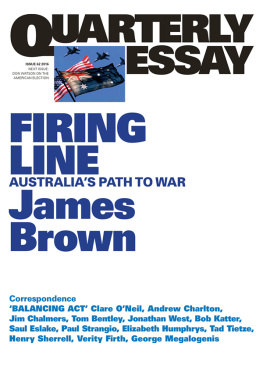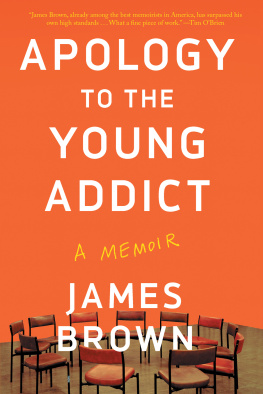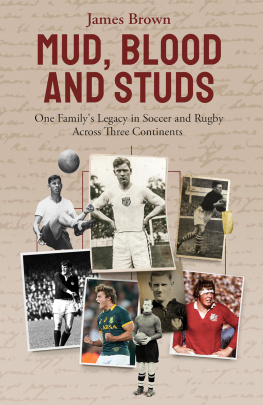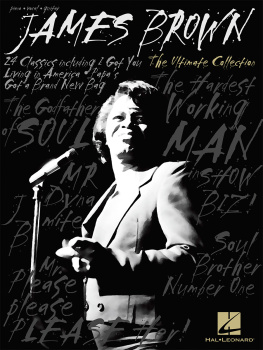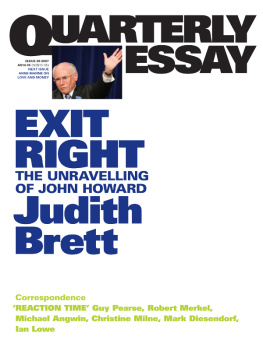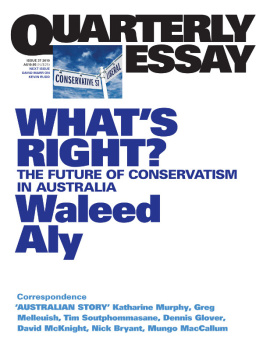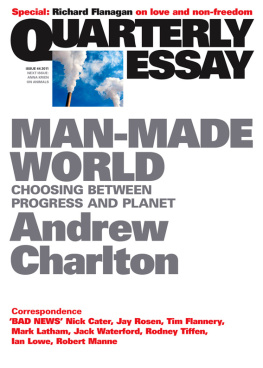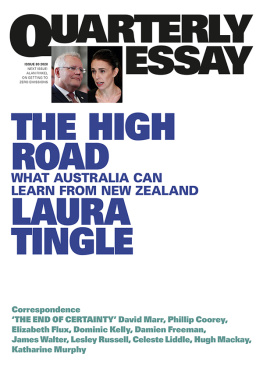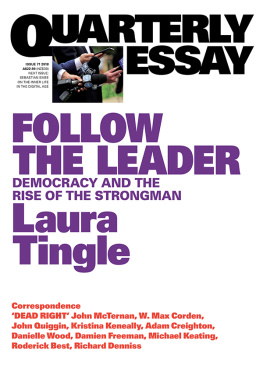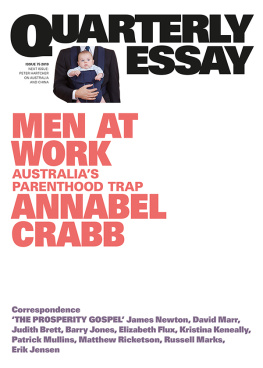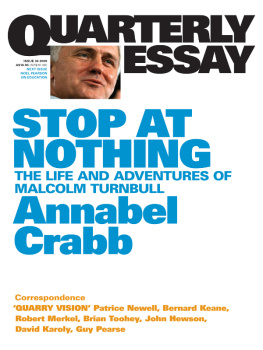Quarterly Essay is published four times a year by Black Inc., an imprint of Schwartz Publishing Pty Ltd. Publisher: Morry Schwartz.
ISBN 978-1-92543-501-6 ISSN 1832-0953
ALL RIGHTS RESERVED.
No part of this publication may be reproduced, stored in a retrieval system, or transmitted in any form by any means electronic, mechanical, photocopying, recording or otherwise without the prior consent of the publishers.
Essay & correspondence retained by the authors.
Subscriptions 1 year print & digital (4 issues): $79.95 within Australia incl. GST. Outside Australia $119.95. 2 years print & digital (8 issues): $129.95 within Australia incl. GST. 1 year digital only: $39.95.
Payment may be made by Mastercard or Visa, or by cheque made out to Schwartz Publishing. Payment includes postage and handling.
To subscribe, fill out and post the subscription card or form inside this issue, or subscribe online:
www.quarterlyessay.com
Phone: 61 3 9486 0288
Correspondence should be addressed to:
The Editor, Quarterly Essay
Level 1, 221 Drummond Street
Carlton VIC 3053 Australia
Phone: 61 3 9486 0288 / Fax: 61 3 9011 6106
Email:
Editor: Chris Feik. Management: Caitlin Yates.
Publicity: Anna Lensky. Design: Guy Mirabella.
Assistant Editor: Kirstie Innes-Will. Production
Coordinator: Sin Scott-Clash. Typesetting: Tristan Main.
FIRING LINE | Australias Path to War |
James Brown |
Before I went to Hiroshima I did not know the word hypocentre. It didnt exist for me until I found it on a wall in the Hiroshima Peace Memorial Museum, past the diorama of children with charred skin flaps hanging from their outstretched arms. But there, hanging a precise distance above the clean model of a cityscape, was a polished plastic red ball: the hypocentre of the nuclear fireball of August 1945.
Before I went to North Korea and stood in a red-lit burial chamber to stare at the forever-set face of Kim Jong-il I had never felt the chill of a regime that could pull you aside, beat out your teeth and swallow you whole. Under the attentive gaze of his sons soldiers and henchmen, in that high-vaulted room displaying his body, I understood what it was to feel insignificant, impuissant my existence the whim of someone elses machinations and politics.
Before I went to the Solomon Islands I had never peered down into the hull of a warship sunk with all hands and understood what it meant to be part of a great armada engaged in a desperate struggle. Nor seen what it meant for a finely crafted military campaign to be suddenly stopped, with either stratagem or luck snuffing out the lives of the defeated.
Before I went to Beirut I had not understood that in the space of two decades a beautiful city could decay, wracked by war and ruin, riven by rivalries. That law and order and commerce could give way to rule by gang. That life could mean rising every day to look south at a neighbouring valley with pure hatred.
Before I went to Iraq I had not tasted dust swept by desert winds from the top of a grave packed deep with hundreds of bodies the remains of those who had refused to go on fighting Saddams war against Iran. Nor sipped cool water inside the armour of a vehicle driving through a suburb thick with fighters wanting nothing more than to kill people like me.
Before I went to Afghanistan I had never listened to men calmly discuss the calibrated effect of their plans for the casual murder of civilians.
And before I came home to Australia from these places I had never really understood what it means to live in a place of bright skies and open minds. When you live in a country like ours, the dirty business of war is a stranger. That is the blessed legacy of a place where soldiers are rarely seen, and then only on parade. Where war means Anzac Day, and Anzac Days are all the same. There are few moments in modern Australia when you might pause to ask the most consequential of questions a question that probes a nations heart, scours its mind and resets the rhythm of its citizens lives.
What is it that we are willing to fight for?
For what principles, what positions, would we stand up and never give in, no matter how great the struggle and how large the cost? And just as importantly, for what would we not fight? On what issues would we stand down, pack up our arms, decide to compromise or to walk away from a fight that is not ours? It is the most important question that governments and the people who elect them might ever have to answer. It is a question that is becoming more difficult for Australians to consider.
For much of Australias history, the sliding and shifting tectonic plates of geopolitics have positioned our continent far from global strife. And in any case, we did not have the authority to decide on war, vested as it was in the hands of the colonial redcoat governors and successive British governments. The question of organising for national defence was at the heart of Henry Parkes Tenterfield Oration and the planning for federation. But Australia herself only decided for war after the Statute of Westminster and the successive declarations of our governor-general in 1942 against Bulgaria and Thailand. Three years later the power to declare war, outside of an attack on our own borders, was largely surrendered to the United Nations. In the years since, some would argue, the decision has been ceded to our great ally the United States.
Perhaps for many Australians the answer is simple. We fight for all that lies within the white wash of waves breaking against our shore, the boundary of our sea-girt nation. That line on our mental map is clear and stark, the idea of physical invasion a natural concept for a country schooled to picture history as a series of landings of boats ashore: be it Botany Bay or Gallipoli. But that mental line has moved further and further outwards, pushed by myriad factors since 1945. The 1982 United Nations Convention on the Law of the Sea stretched the line far out beyond the crashing surf and into an exclusive economic zone extending 200 nautical miles in all directions. A deep blue inkblot of sovereignty leaches into the Indian Ocean, north to Timor, east by New Zealand and the Pacific Islands, south across the Antarctic. At 27.2 million square kilometres, Australias jurisdictional claim on the earths surface is the largest of any country in the world.
The ambitions of a prosperous country in a globalising world blur and broaden the lines of our security, too. A country like ours, dependent on trade across the oceans, necessarily has veins that extend inwards, outwards and across borders: free-flowing lines carrying energy, food, ideas, stories and relationships. An interconnected country linked by cables draped across the ocean floor: digital highways carrying the traffic to connect our financial transactions as well as our medical researchers. Modern Australia breathes because planes can ascend from Tullamarine, circle the planet and glide to a landing at Heathrow, John F. Kennedy or Shanghai. Because oil can decant through the Strait of Hormuz into Singapore and Taiwan, then trickle down through the Indonesian archipelago to fill sedans and shops and shelves. Because satellites above can blink signals scheduling trains across the Nullarbor or surveying fires in the Pilliga. Our way of life, on reflection, is a surprisingly intricate thing. An exquisite thing, dependent on a fine global web of collaborations. A system of transactions anchored by trust and stability. Australias security depends on lifelines that run from here across the planet.

